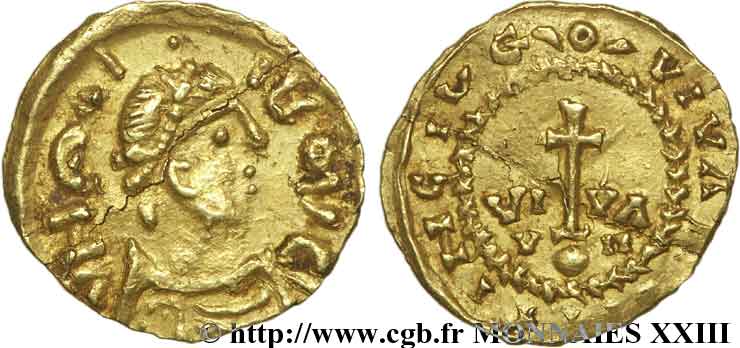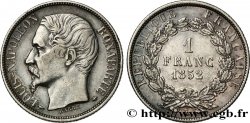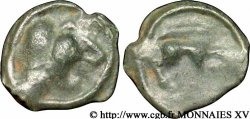v23_0915 - VIVIERS (VIVARIA CIVITAS) - Ardèche Triens de 7 siliques au nom d'Héraclius (610-641)
MONNAIES 23 (2004)
Начальная цена : 1 200.00 €
Назначить цену : 2 000.00 €
Цена реализации : 1 820.00 €
Количество ставок : 2
Максимальная предлагаемая цена : 1 820.00 €
Начальная цена : 1 200.00 €
Назначить цену : 2 000.00 €
Цена реализации : 1 820.00 €
Количество ставок : 2
Максимальная предлагаемая цена : 1 820.00 €
Тип Triens de 7 siliques au nom d'Héraclius (610-641)
Дата: (VIIe siècle)
Монетный двор / Город: VIVIERS
Металл: gold
Диаметр: 14 mm
Ориентация осей монеты: 6 h.
Вес: 1,33 g.
Редкость: R2
Комментарии о состоянии
Bel exemplaire sur un flan large avec une trace de pliure importante des deux côtés. Poids lourd pour un triens de 7 siliques
Ссылки в каталоге: :
Происхождение:
Cet exemplaire provient de MONNAIES V, n° 651
Лицевая сторона
Аверс: легенда: VNCAI.IROVGI.
Аверс: описание: Buste diadémé, drapé à droite, légende autour.
Обратная сторона
Реверс: легенда: VIVA (...) INCIVG.
Реверс: Описание: Croix latine sur un degré accostée des lettres VI - VA/ V-II, dans une couronne de feuillage dont le nœud d'attache immobilisé commence la légende.
Комментарий
La légende du droit est complète, mais difficilement lisible, avec des lettres rétrogrades et renversées (identique au Belfort n° 4920). Au revers, la légende est nette et très différente de celle décrite pour le Belfort n° 4920 (lue WIVOAVIRONESTVS). Hormis la légende, le type de revers est d'ailleurs celui du Belfort n° 4919, avec le nœud de la couronne de feuillage du n° 4920. Nous avons ici un monnayage imité des monnaies de Marseille pour la cité de Viviers, siège d'un Évêché depuis le IVe siècle. Ce triens dont le poids est indiqué au revers dans le champ est léger, 7 siliques contre 8 pour un tremissis byzantin. le solidus pesait 4 scrupules ou 24 siliques (4,51 g.). En Gaule, le poids du solidus avait été ramené à 21 siliques (3,94 g.). Au VIème siècle le commerce n'a pas cessé entre Byzance et la Gaule, les échanges sont différents, la monnaie circule moins bien. Le commerce maritime est entre les mains des "Syriens", commerçants du monde méditerranéen qui amènent dans la grande cité phocéenne les produits venant d'Orient.
The legend on the obverse is complete, but difficult to read, with retrograde and inverted letters (identical to Belfort No. 4920). On the reverse, the legend is clear and very different from that described for Belfort No. 4920 (read WIVOAVIRONESTVS). Apart from the legend, the reverse type is also that of Belfort No. 4919, with the knot of the foliage crown of No. 4920. We have here a coinage imitated from the coins of Marseille for the city of Viviers, seat of a Bishopric since the 4th century. This triens whose weight is indicated on the reverse in the field is light, 7 siliquae compared to 8 for a Byzantine tremissis. The solidus weighed 4 scruples or 24 siliquae (4.51 g). In Gaul, the weight of the solidus had been reduced to 21 siliquae (3.94 g). In the 6th century, trade between Byzantium and Gaul continued; exchanges were different, and coin circulated less easily. Maritime trade was in the hands of the \\\"Syrians,\\\" traders from the Mediterranean world who brought products from the Orient to the great Phocaean city.
The legend on the obverse is complete, but difficult to read, with retrograde and inverted letters (identical to Belfort No. 4920). On the reverse, the legend is clear and very different from that described for Belfort No. 4920 (read WIVOAVIRONESTVS). Apart from the legend, the reverse type is also that of Belfort No. 4919, with the knot of the foliage crown of No. 4920. We have here a coinage imitated from the coins of Marseille for the city of Viviers, seat of a Bishopric since the 4th century. This triens whose weight is indicated on the reverse in the field is light, 7 siliquae compared to 8 for a Byzantine tremissis. The solidus weighed 4 scruples or 24 siliquae (4.51 g). In Gaul, the weight of the solidus had been reduced to 21 siliquae (3.94 g). In the 6th century, trade between Byzantium and Gaul continued; exchanges were different, and coin circulated less easily. Maritime trade was in the hands of the \\\"Syrians,\\\" traders from the Mediterranean world who brought products from the Orient to the great Phocaean city.








 Cообщить об ошибке
Cообщить об ошибке Распечатать страницу
Распечатать страницу Отправить мой выбор
Отправить мой выбор Задать вопрос
Задать вопрос Consign / sell
Consign / sell










